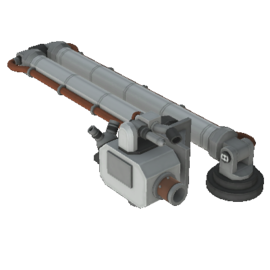OP-E Large Scanning Arm
| Available only with the Breaking Ground Expansion installed. |
| OP-E Large Scanning Arm | ||
| Scanning arm by Experimental Engineering Group | ||
| Radial size | Radial mounted | |
| Cost | (total) | 800.00 |
| Mass | (total) | 0.30 t |
| Drag | 0.2 | |
| Max. Temp. | 2000 K | |
| Volume | ? | |
| Impact Tolerance | 12 m/s | |
| Research | | |
| Unlock cost | 8 000 | |
| Since version | 1.7.1 | |
| Part configuration | RobotArmScanner_S3.cfg | |
| Reach | 4.0 m | |
| Electricity required | 26.8 ⚡/s | |
| Experiment | roc[unknown] | |
| Electricity required | None | |
Contents
Product description
| “ | The Experimental Engineering Group's marketing department claims this is another once in a lifetime achievement. We're starting to get suspicious! Nonetheless, this even larger rover arm has four separate instruments, and we can't think of what else they might add, so this is probably the top of the line model from them. — Experimental Engineering Group |
” |
Usage
Search for a surface feature from the Breaking Ground expansion, they can be found either by flyby or by using the ROC finder in the cheat menu.
Warning: Surface features may not be active if you continue a saved game right after buying the extension. There is a (risky) workaround for this.
Here are their location per biome.
Once the surface feature is found, get close to it and right-click on the arm to start the scan. The ship must be at a full stop and the arm must have enough room and electricity to perform the experiment. In total you will need ~500 EC to run the experiment from start to finish.
When the experiment is finished you'll have a standard experiment report. You can right-click on the arm while controling a Kerbal to take the experiment with you.
Science reward
The arm experiment is bound to the same multipliers than any other experiment: the difficulty science multiplier (default, 100%) and the surface/body multiplier (for example Kerbin's surface is 0,3x and Mun's surface is 4x). The experiment is always full, can be fully transmitted and will only occur once per body.
Surface features are split into three rewards : 30, 45 or 60 base science points (before the multipliers).
| Body | 30 base points | 45 base points | 60 base points |
|---|---|---|---|
| Kerbin | GiantQuartz | BaobabTree | |
| Mun | Stone | Crater | LargeCrater |
| Minmus | GreenSandstone | OlivineFormation | |
| Moho | Stone | WrinkleRidge | |
| Eve | VolcanicRock | BasaltFormation | PancakeDome |
| Gilly | Ridgeline | ||
| Duna | Stone, Blueberries | Meteorite | Dune |
| Ike | DunaEjectaOnIke | ||
| Dres | Meteorite | Crater | |
| Laythe | Stone | Boulder | Geyser |
| Vall | IceChunk | Stone | CryoVolcano |
| Tylo | LightStone | DarkBoulder | Checkerboard |
| Bop | GravelPile | ||
| Pol | YellowStones | ||
| Eeloo | IceChunk | BrownBoulder | EelooBerg |
Trivia
Real-world comparison
The name OP-E is an abbreviation of the Mars rover Opportunity (Oppy).
Changes
- Initial Release
| ||||||||||||||||||||||||||||||||||||||||||||||||||||||||||||||||
